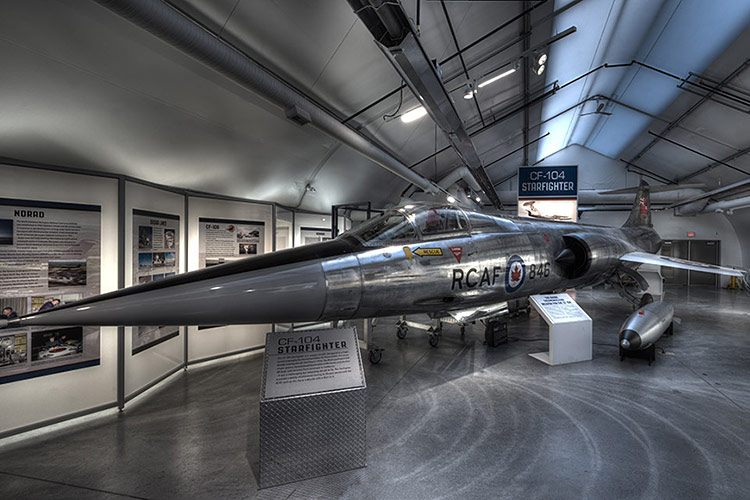
Air Force Museum of Alberta
Opened in 2009, the Air Force Museum of Alberta (AFMA) is the newest addition to The Military Museums. The AFMA chronicles the story of Canada’s Air Force through artefacts, models, interactive displays, and unique films.
Although the Royal Canadian Air Force was not founded until 1 April 1924, the AFMA begins with the 15th century flying machine of Leonardo da Vinci and ends with the modern role of the Canadian Air Force, covering the magnificent legacy of Canada’s war-time contributions in between.
Air Force Museum of Alberta
Development of Early Flight
Humanity’s first serious attempts at flight began in the 15th century with the inventions of Leonardo da Vinci but success wasn’t met until the first decade of the 20th century. The Wright brothers performed the first successful heavier-than-air flight in 1903 and Canada echoed that triumph in 1909 with the Silver Dart, designed by Alexander Graham Bell, and piloted by J.D. McCurdy.
The First World War
The airplane quickly became a tool of war, despite the scepticism of Sam Hughes, Canadian Minister of Militia and Defence. Canada did not have its own air force in the First World War but Canadian airmen served with the British Royal Flying Corps, later the Royal Air Force (RAF) and The Royal Naval Air Service (RNAS). Of these men, 192 emerged as “aces,” having destroyed more than five enemy aircraft each. W.A. “Billy” Bishop and William Raymond Collishaw topped this list, becoming household names that remain familiar to us even a century later.
Between the Wars
The interwar years proved significant for the growth of Canada’s air force. The Royal Canadian Air Force (RCAF) was founded on 1 April 1924 and consisted of only 62 officers and 262 airmen. From here, it grew slowly but steadily, carrying out tasks like aerial photography and mapping as well as personnel transport into and from the remotest regions of our country.
Bomber Command and No.6 Group
When the Second World War broke out, the RCAF had a total Permanent Force strength of only 298 officers and 2,750 men. But these numbers grew rapidly. By 1943, Canada had its own group within Bomber Command of the RAF, which consisted of fifteen squadrons, flying Lancasters, Halifaxes and Wellingtons.
The Bomber Command exhibit retells the fascinating story of No. 6 (RCAF) Group and features reproductions of aircraft nose-art painted on original aircraft exteriors. You can even experience a pre-flight briefing in an authentic Second World War Nissen hut, the first of our two theatres.
British Commonwealth Air Training Program
The British Commonwealth Air Training Program (BCATP) was developed after the Luftwaffe (German Air Force) made it too hazardous to train aircrew in Britain. Between 1940 and 1945, the BCATP trained more than 130,000 airmen from Canada, Britain, Australia and New Zealand.
Enough material was used in constructing runways for this program that a similar amount could pave a highway from Vancouver to Ottawa. Find out just how large the BCATP was with a specialized interactive that outlines school locations, recruiting posters used, and descriptions of trainer aircraft.
RCAF Operations Overseas
Did you know that the Battle of Britain was the first campaign for Canadian airmen in a solely Canadian unit? In addition to No. 6 Bomber Group, the RCAF had squadrons of fighters and nightfighters stationed in Britain throughout the Second World War, as well as two transport squadrons located in the Far East.
In this display, you can also discover the genius of Sydney Shulemson, DSO, DFC, who developed a systematic unguided rocket attack for sinking ships that was used until the invention of laser guided rockets.
The Cold War
With the development of NORAD and NATO, the Cold War saw Canada look to the defence of its northern boundaries. Additionally, as part of the nation’s commitment to these alliances, operational squadrons were deployed to Europe. Learn about aircraft advancements and view a M3 .50 Calibre Browning machine gun used in the F-86 Sabre jet fighter.
Two new hangars on the grounds of The Military Museums (TMM) are home to a CF-18 Hornet, a CF-104 Starfighter, and a F-86 Sabre Jet fighter. The hangars and these Cold War Era fighters are part of a new exhibit that pay tribute to the Canadians who stood ready to defend Canada throughout the Cold War.
The Modern Era
Today, the Canadian Air Force (CAF) fulfills a variety of tasks. View actual footage of day-to-day operations in our second theatre, specially designed to look like the interior of a Hercules aircraft, and learn about fighter pilot training programs at Cold Lake with our interactive touch-screen.
Whether through artefacts, models, interactive displays or simply stunning graphics, our museum has something to offer everyone. Come and see a piece of the Red Baron’s plane, view the uniform worn by Wilfrid ‘Wop’ May, and view exclusive movies about Canadian bomber squadrons – only at the Air Force Museum of Alberta!